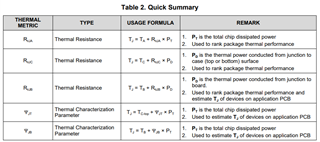Tool/software:
I am looking to figure out how Ti determines the junction temperature for the following devices.
TXB0102DCURG4
TCA9517DGKRQ1
TCA9546APWR
SN65LBC172A16DWR
SN74LVC8T245PW
SN65LBC174A16DWRG4
This thread has been locked.
If you have a related question, please click the "Ask a related question" button in the top right corner. The newly created question will be automatically linked to this question.
Tool/software:
I am looking to figure out how Ti determines the junction temperature for the following devices.
TXB0102DCURG4
TCA9517DGKRQ1
TCA9546APWR
SN65LBC172A16DWR
SN74LVC8T245PW
SN65LBC174A16DWRG4
Hi Isaac,
This app note goes into detail on this:
How to Properly Evaluate Junction Temperature with Thermal Metrics
Effectively, we use the thermals and calculate.

For many of these devices, if not all, the Tj(max) will be equal to the max storage temperature though, typically listed in the abs max rating table. If it's not stated, it will be 150C.
However, if you use most of these low power device at their max stress, so max on the datasheet specifications allowed, it's unlikely you'll exceed the max allowed Tj(max). It is to note that this doesn't mean you can exceed the datasheet ratings as long as you're below Tj(max). The datasheet ratings are the limits before damage and should always be adhered to.
Thanks,
Rami
So I have a couple more questions that may be more generalized about this thinking.
My understanding is that TI has a post on this already under e2e.ti.com/.../faq-what-is-the-maximum-junction-temperature-tjmax-for-a-device
However I would like more clarification on this. Maybe I have the wrong idea but is it correct to say that Max junction temperature is equal to max storage temp in all cases? My understanding is that junction temp the device would be the max operational temperature of the die of the device in operation vs storage temperature where the device is unpowered.
I would also like some clarification on operating temperature in regards to junction temperature. I take it that junction temperature is still the max operational temperature of the die, where the operating temp stated on the datasheet is the recommended environment the device is used in? Another question regarding this is will performance be effected by the operational temperature stated in most datasheets, or is this more based off of the junction temperature? I ask this because TI states in their datasheets that the recommended operating temp range is -40C to 85C, where as the junction temp would be 150C.
I ask this because my concern is should I be using an EP variant for mil spec applications for better operating temperature environments? or can I use an industrial part with a lower operating temperature as long as the junction temp will pass according to our derating standards?
The TJ(max) value specified (or implied) in the absolute maximum ratings is the maximum allowed temperature at which the die does not get damaged. It's almost always 150 °C because it is a physical characteristic of the silicon.
When in storage, the junction temperature is the same as the ambient temperature.
When operating, the junction temperature is higher than the ambient temperature because the energy dissipated inside the device does not immediately flow to the outside (TJ = TA + RθJA × P).
"Operating temperature" alone usually means the same as "ambient temperature".
To ensure that the device does not get damaged, you have to stay inside the absolute maximum ratings.
To ensure that the device works correctly, you have to stay inside the recommended operating conditions.
The minimum/maximum electrical characteristics are usually specified over the entire operating temperature range, so this is what you should choose the rating with.